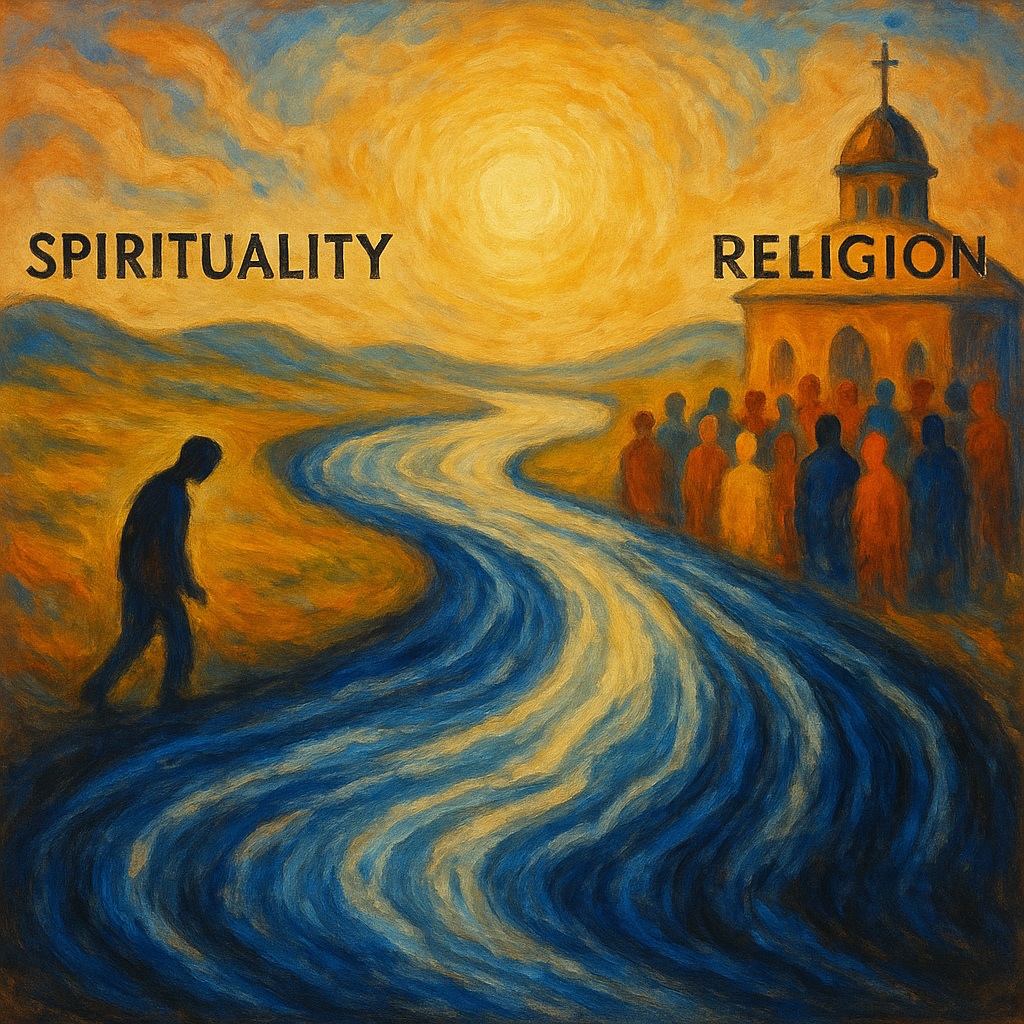
In today’s world of inner searching and outer chaos, many seekers are asking: what’s the difference between spiritualism and religion? And can the two walk hand-in-hand? At the heart of human longing lies a profound spiritual question—and the answer may not be either/or, but beautifully both.
In the silent chambers of the heart, where whispers of eternity dwell, two rivers flow—one named Spiritualism, the other Religion. One is a wild, untamed stream, carving its own path through the valleys of solitude. The other, a mighty river, shaped by the hands of centuries, carrying the prayers of generations.
And yet, are they not both waters from the same divine spring?
The Whisper of Spiritualism: A Solitary Pilgrimage
Spiritualism is the breath of the unseen, the voice that speaks in the hush of dawn, in the stillness between thoughts. It is not bound by temple walls or sacred texts, for its altar is the open sky, its scripture written in the trembling leaves and the sigh of the wind.
As the mystic Rumi once murmured, “The wound is where the light enters you.” And so, the spiritual seeker kneels not before an idol, but before the vastness within—where sorrow and ecstasy are but two notes in the same eternal song.
Alan Kardec, the philosopher of spirits, called it “the science of the soul’s journey.” For in spiritualism, there are no intermediaries—only the soul and the infinite, dancing in silent communion.
The Sanctuary of Religion: A Chorus of the Faithful
Yet, what of religion? Religion provides the structure, the sacred rituals, and the shared community that many spiritual seekers yearn for. It is the hearth around which weary travelers gather, the hymn that rises from a thousand lips, weaving a tapestry of shared devotion.
It is the hand that guides, the story passed from mother to child, the ritual that binds time itself.
Nietzsche, the prophet of solitude, once said, “There is not enough love in the world to make people give up their gods.” And so, religion stands—not as chains, but as wings, lifting the collective spirit toward the divine.
In the mosque, the church, the temple, the synagogue—each prayer is a thread in the grand design. As Gandhi, the saint of peace, whispered, “Religion is a matter of the heart.” It is not doctrine alone, but the pulse of belonging, the rhythm of a faith that walks beside you.
Where the Two Rivers Meet: A Marriage of Heaven and Earth
Can the mystic and the devotee walk the same path? Can the solitary seeker and the faithful congregant drink from the same well?
In our spiritually evolving world, the intersection of religion and spiritualism is not a contradiction—it’s a conversation. The modern soul stands at this crossroads, where ancient rituals and personal revelations entwine like vines upon a sacred tree. Karen Armstrong, the scholar of faith, reminds us: “We are all humans, seeking the same light.”
Perhaps the answer lies not in choosing one over the other, but in letting them dance—each step a harmony, each turn a revelation.
Five Keys to the Sacred Union of Religion and Spiritualism
- Seek the Common Flame: Behind every ritual, every meditation, there burns a single truth—love. The Dalai Lama’s words echo: “Compassion is not a luxury; it is the air the soul breathes.”
- Let the Soul Wander Freely: Some find God in the cathedral’s-stained glass, others in the forest’s sigh. Neither path is wrong—only different verses of the same sacred hymn.
- Honor the Many Names of the Divine: As Thomas Merton said, “We are all called to be saints, yet each in our own way.” Let not the name divide what the heart unites. Whether one says Allah, Krishna, Yahweh, or Universe—the yearning is the same.
- Build Bridges, Not Walls: Let there be gatherings where the chant of monks meets the silence of the meditator—where all voices rise in one song, honoring interfaith unity and spiritual diversity.
- Remember the Ancient Story: History is the loom upon which faith is woven. To know the past is to walk with softer steps upon the sacred ground. Whether you study sacred texts or ancient philosophies, all roots trace back to a shared human longing for meaning.
The Eternal Pilgrimage: One Path, Many Footsteps
Lao Tzu, the sage of the Tao, whispered, “The journey of a thousand miles begins beneath your feet.” And so, we walk—some with prayer beads in hand, some with eyes closed in inward gaze.
But the destination is the same.
For whether we name it God, Spirit, Universe, or Love—it is the same light that calls us home. And perhaps, just perhaps, religion and spiritualism are not separate roads, but different languages spoken by the same yearning soul.
Let us then walk together, not as rivals, but as fellow pilgrims in the great and holy mystery of being.
Why This Spiritual Conversation Matters Today
In a world fractured by division and overwhelmed by distraction, the marriage of spiritualism and religion is not mere philosophy—it is survival. It is the antidote to loneliness, the cure for dogma, the bridge between solitude and communion.
By understanding both paths, we move beyond spiritual confusion and toward soulful clarity. We learn to respect diversity, foster inner peace, and nurture a global sense of belonging.
May your journey be blessed with both—the wild freedom of the mystic and the warm embrace of the faithful.
For in the end, all rivers return to the same ocean.

